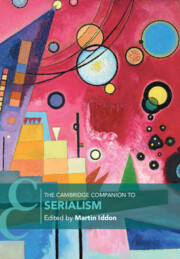Book contents
- The Cambridge Companion to Serialism
- Cambridge Companions to Music
- The Cambridge Companion to Serialism
- Copyright page
- Contents
- Figures
- Tables
- Contributors
- Preface
- Part I Contexts I
- Part II Composers
- 4 Arnold Schoenberg and the ‘Musical Idea’
- 5 Alban Berg’s Eclectic Serialism
- 6 Rethinking Late Webern
- 7 Milton Babbitt and ‘Total’ Serialism
- 8 Pierre Boulez and the Redefinition of Serialism
- 9 The Serial Music of Karlheinz Stockhausen
- 10 Luigi Nono and the Development of Serial Technique
- 11 Stravinsky’s Path to Serialism
- Part III Geographies
- Part IV Contexts II
- References
- Index
11 - Stravinsky’s Path to Serialism
from Part II - Composers
Published online by Cambridge University Press: 07 March 2023
- The Cambridge Companion to Serialism
- Cambridge Companions to Music
- The Cambridge Companion to Serialism
- Copyright page
- Contents
- Figures
- Tables
- Contributors
- Preface
- Part I Contexts I
- Part II Composers
- 4 Arnold Schoenberg and the ‘Musical Idea’
- 5 Alban Berg’s Eclectic Serialism
- 6 Rethinking Late Webern
- 7 Milton Babbitt and ‘Total’ Serialism
- 8 Pierre Boulez and the Redefinition of Serialism
- 9 The Serial Music of Karlheinz Stockhausen
- 10 Luigi Nono and the Development of Serial Technique
- 11 Stravinsky’s Path to Serialism
- Part III Geographies
- Part IV Contexts II
- References
- Index
Summary
It was inevitable that Igor Stravinsky would experiment with serialism, given his penchant for interval-based composition, even making a comment to Milton Babbitt that he had always composed with intervals. Stravinsky’s intrigue with intervallic patterns is significant in some of his earlier works – particularly the motivic networks supporting the narratives of Firebird (1910) and Perséphone (1934). In fact, examining the interval ordering in the motives from these works, Stravinsky, perhaps unwittingly, retains the exact order of intervals while producing twelve different pitch classes. In retrospect, this seems to have foreshadowed the development of his own brand of serialism in his later years, beginning with Cantata in 1952, and maturing over the fourteen years through works such as Septet, In Memoriam Dylan Thomas, Canticum Sacrum, Threni, Agon, Movements for Piano and Orchestra, A Sermon, a Narrative, and a Prayer, Variations: Aldous Huxley in memoriam, Abraham and Isaac, Elegy for J.F.K., Introitus: T.S. Eliot in memoriam, and his last major work, Requiem Canticles, in 1966.
Keywords
- Type
- Chapter
- Information
- The Cambridge Companion to Serialism , pp. 183 - 202Publisher: Cambridge University PressPrint publication year: 2023

